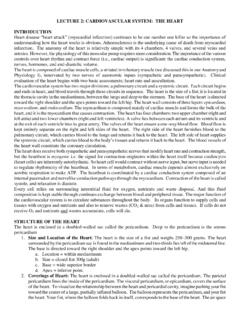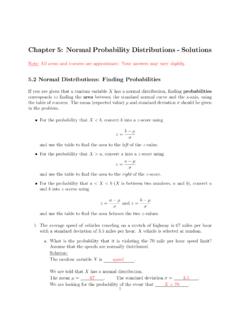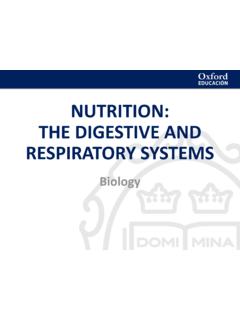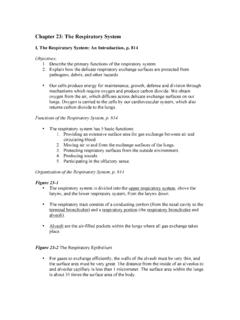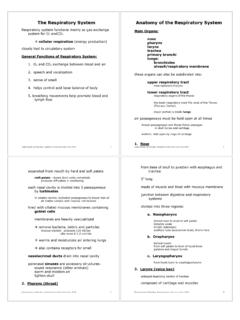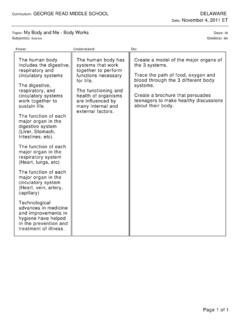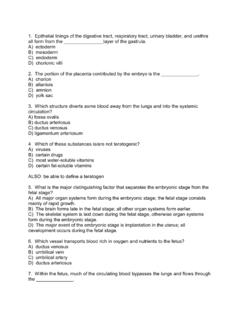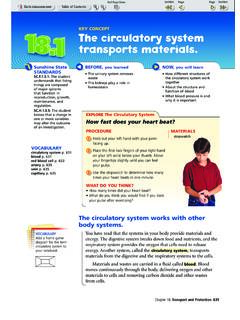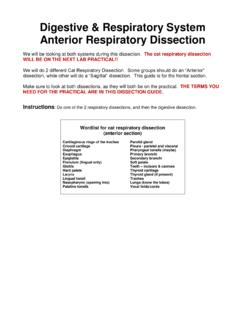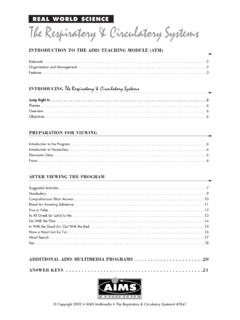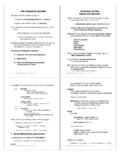Transcription of LECTURE 5: RESPIRATORY SYSTEM INTRODUCTION
1 LECTURE 5: RESPIRATORY SYSTEM INTRODUCTION The RESPIRATORY SYSTEM is composed of structures involved in ventilation (airflow to and from the lungs) and gas exchange to supply blood with oxygen and remove carbon dioxide from the blood. The RESPIRATORY SYSTEM does this through ventilation, gas exchange between alveoli and capillaries, transportation of oxygen from the lungs to the cells; gas exchange between cells and capillaries and delivery of carbon dioxide from the cells to the lungs. In summary events of respiration includes ventilation, external and internal respiration, and cellular respiration. Ventilation activities ensure that air moves in and out of the alveoli in sufficient quantities to supply the needs of the cells involved in oxidative cell respiration. Every cell in our body needs energy, and they obtain their energy via cellular respiration (aerobically means need oxygen), thus oxygen should be delivered to each cell continuously.
2 Our cardiovascular SYSTEM provides a link between the lungs and all the cells throughout the body. Therefore the ultimate function of breathing is to deliver oxygen to cells, where it takes part in the reactions of cellular respiration that liberate energy from nutrient molecules and get rid of carbon dioxide, which maintains the pH of the internal environment. The passageway that carries air from nose to the alveoli and from alveoli to the nose makes up the RESPIRATORY tract. The RESPIRATORY tract is divided into upper (nose, nasal cavity, sinuses and pharynx) and lower (larynx, trachea, bronchi, bronchiole, and alveoli) RESPIRATORY SYSTEM . Air enters the upper RESPIRATORY SYSTEM it is filtered, humidified and warmed, before reaching the lungs upper RESPIRATORY SYSTEM filters, worms and humidifies incoming air to protect the more delicate surface of lower RESPIRATORY SYSTEM . Think of the mucus layer of the RESPIRATORY epithelium as a sticky flypaper that traps potentially troubling particles (flies or microbes) from the surrounding airstream.
3 The lower RESPIRATORY SYSTEM conduct air to the air filled pockets (called alveoli) where gas exchange occurs between air and blood oxygen of the inhaled air from alveoli diffuses into the capillaries and carbon dioxide diffuses from the capillaries to the alveoli. After the gas exchange the carbon dioxide follows the same path out of the lungs when we exhale. OVERVIEW 1. The RESPIRATORY SYSTEM consists of passageways that filter incoming air and ultimately transport it into the microscopic air sacs where gases are exchanged. 2. The entire process of exchanging gases between the atmosphere and body cells is called respiration. 3. Respiration includes 5 parts: a. Ventilation = breathing b. External respiration = air into lungs gas exchange (O2 load into the capillaries/ CO2 unload from the capillaries) air out exchange between atmospheric air (external environment) and capillaries or you could say that external respiration is diffusion of gases between the alveoli and the circulating blood.
4 C. Transport of RESPIRATORY gases = gases in blood transported from lungs to body cells and back to lungs delivery of oxygen from the lungs to the cells and delivery of carbon dioxide from the cells back to the lungs d. Internal respiration = exchange of gases at body capillaries (O2 unload from capillaries to the cell/CO2 load from cells to the capillaries oxygen dissociates from Hb and diffuses out of RBC and then out of capillaries and enter the cells of peripheral tissue; carbon dioxide diffuses from the cells of peripheral tissue into the capillaries and then into the RBC and some bind to Hb and the rest is converted to bicarbonate ion). e. Cellular respiration = use of oxygen by cells to produce energy (production of CO2). f. Only ventilation and external respiration are accomplished by RESPIRATORY SYSTEM organs. Transport of RESPIRATORY gases and internal respiration is achieved by cardiovascular SYSTEM and cellular respiration is achieved by cellular metabolism (chemical reactions that take place inside the cell) WHY WE BREATH?
5 Respiration is necessary because of cellular respiration, the process by which animal cells use oxygen to release energy from nutrients we eat. The metabolic waste gas, carbon dioxide is produced during cellular respiration, and it must be transported to the lungs to be expelled. ORGANS OF THE RESPIRATORY SYSTEM The organs of the RESPIRATORY SYSTEM can be divided into two groups, or tracts. Those in the upper RESPIRATORY tract include the nose, nasal cavity, sinuses, and pharynx. Those in the lower RESPIRATORY tract include the larynx, trachea, bronchial tree, and lungs. UPPER RESPIRATORY SYSTEM 1. The upper RESPIRATORY organs are lined with mucous membranes. Its function include to: warm incoming air; moisten incoming air; entrap dust, microorganisms, and particles a. Epithelium over connective tissue with many goblet cells (mucus). i. The mucus functions to trap debris. ii. The cilia beat the debris to the pharynx to be swallowed and destroyed by digestive enzymes.
6 Note: A healthy RESPIRATORY SYSTEM is continuously cleansed. The sticky mucus produced by the mucus cells batches the exposed surface of RESPIRATORY passageway. As air passes through the passage way sticky mucus traps dirt, microorganisms, debris and pathogens. The continuous beating of cilia sweeps trapped material toward the mouth (pharynx), where they can be swallowed and eliminated by the stomach acid. Smoking greatly impairs this housekeeping by slowing the beating of cilia. In cystic fibrosis the mucus cells produce abnormally thick and sticky mucus, thus beating of cilia cannot sweep the dense mucus. Mucus accumulates and restricts airflow and could block smaller air passageways. iii. This tissue also serves to warm and moisten incoming air. 2. Nose (external nares or nostrils) a. Nose consists of or includes bone and cartilage with internal hairs (hairs traps large particles filters air) 3. Nasal cavity (separated by nasal septum) a.
7 Bone and cartilage of nasal cavity are lined with mucous membranes b. Warms and moistens incoming air c. Olfactory reception d. Resonating chambers for speech 4. Nasal conchae a. Within the nasal cavity there are superior, middle, and inferior bones called conchae b. Conchae divide nasal cavity into a series of groove-like passageway c. Conchae are lined by mucous membranes d. Function of nasal conchae is to increase turbulence of incoming air in order to better warm, moisten, and filter. As air passes through the conchae, it create turbulence in the air so as to trap small particulates in mucus passing air will bounce up and down and microorganism and small particles will also bounce, and as they bounce up and down small particles and microorganisms will stick to the sticky mucus. 5. Paranasal sinuses a. Recall from A&P I that sinuses are air-filled spaces in the frontal, sphenoid, ethmoid, and maxillary bones of the skull.
8 These spaces open into the nasal cavity and are lined with mucous membranes that are continuous with the lining of the nasal cavity, so mucus secretions drain from the sinuses into the nasal cavity b. During inflammation (swollen of membrane) of the membrane due to nasal infections or allergic reactions the opening to the nasal cavity could become block and prevent drainage of mucus secretion into nasal cavity. This may increase pressure in a sinus and cause headache. 6. Pharynx (or throat) a. It is a passageway for air and food shared by both RESPIRATORY SYSTEM and digest SYSTEM . b. Pharynx is divided into three parts: i. Nasopharynx (uppermost, behind nasal cavity) ii. Oropharynx (middle, behind oral cavity) this is the portion of pharynx that is shared by both digestive and RESPIRATORY systems iii. Laryngopharynx (lowest) LOWER RESPIRATORY SYSTEM Organs of lower RESPIRATORY SYSTEM include: 1. Larynx (or voice box) a. Larynx consists of nine pieces of cartilage: 3 large cartilages and 3 pairs of small cartilages.
9 The 3 large cartilages of larynx include: i. Thyroid cartilage (Adam's apple) ii. Epiglottis closes off the airway during swallowing. 1. During swallowing the larynx is elevated and the epiglottis folds back over the glottis, preventing food and water particles from entering into RESPIRATORY tract epiglottis is an elastic cartilage that shields the opening to the larynx during swallowing. 2. Glottis = triangular slit opening between two pairs of vocal cords inhaled air leaves the pharynx and enters the larynx through a narrow opening called glottis. Glottis is the opening to the larynx. iii. Cricoid cartilage = ring of hyaline cartilage attached to first ring of trachea site of tracheotomy. b. Voice production i. Sound production at the larynx is called phonation. Phonation is the first step in speech production. Phonation (sound) produced by vocal fold has to be articulated and modified by tongue, teeth, lips, nasal cavity to produce speech.
10 Ii. Mucous membranes form two pairs of folds. 1. Upper ventricular folds (false vocal cords) 2. Lower vocal folds (true vocal cords) 3. Triangular space between them = glottis. iii. Sound (phonation) originates from vibration of the vocal folds as air passes through the open glottis. 2. Trachea (windpipe) a. Trachea or windpipe is a tough, flexible tube that receive air from the larynx and pass it to the bronchi b. Location = mediastinum anterior to esophagus extends from larynx to T5 (fifth thoracic vertebrae) c. Structure: 16-20 incomplete rings of hyaline cartilage = C-rings i. C shape cartilages hold them open and prevent its collapse or overexpansion as pressure changes within the RESPIRATORY SYSTEM . d. Carina = point where trachea divides into right & left primary bronchi when trachea branches into left and right, it becomes primary bronchi. e. Function = support against collapse, continue to warm, moisten & filter air. 3. Bronchial Tree a. The bronchial tree consists of branched airways leading from the trachea to the microscopic air sacs in the lungs.



